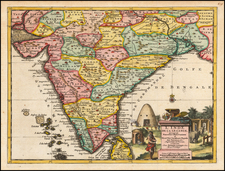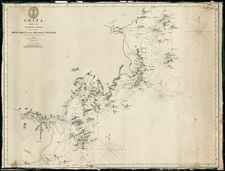Remarkable Topographical Map of The Third Highest Peak in the World of Its Time and Surrounding Glaciers
Fine large format map of a section of the Sikh Himalayas covering Kangchendzonga National Park and the Zemu Glacier, which was included in Paul Bauer's Um Den Kantsch: Der Zweite Deutsche Angriff Auf Den Kangchendzönga 1931, published in Munich in 1933. The accompanying map bears a copyright date of 1932.
Focused on Mount Kangchenjunga and the Glacial areas to the east, the map is the largest and most focused of the region yet produced. The map credits Dr. Karl Wien with technical assistance from the Hans Biersack and the Austrian and German Alpine Clubs.
The map was prepared following the Second German Expedition to sumit Mount Kangchenjunga. In 1931, Paul Bauer led a second German expedition team in an attempt to summit the northeast spur before being turned back by bad weather, illnesses, and deaths. The team, including Peter Aufschnaiter, abandoned the attempt after climbing about 1,000 feet higher than the 1929 attempt by the first German expedition.
The map and report were issued on the heals of so-called International Expedition of 1930. The International party had intended to climb Mount Kangchenjunga but were forced to abandon the climb before reaching its summit. Following this expedition, Marcel Kurz created a large map of the wider region, which was considered the definitive work in the region for a number of years. While Kurz map is quite remarkable, it covers and area roughly 10 times larger than the present map.
Kangchenjunga would finally be successfully climbed in 1955, after one last failed attempt in 1954.
Kangchenjunga
Kangchenjunga, also spelled Kanchenjunga and Khangchendzonga, is the third highest mountain in the world. It lies in the border region between Nepal and Sikkim state of India. Its summit lies at 28,169 ft in the Kangchenjunga Himal, bounded in the west by the Tamur River, in the north by the Lhonak River and Jongsang La, and in the east by the Teesta River.
Until 1852, Kangchenjunga was assumed to be the highest mountain in the world, until the Survey of India corrected the height of the mountain. The Kangchenjunga was first climbed on 25 May 1955 by Joe Brown and George Band, who were part of the 1955 British Kangchenjunga expedition. They stopped just short of the true summit, keeping a promise given to the Chogyal of Sikkim, who regarded the mountain as sacred, that the top of the mountain would remain inviolate.
Provenance: Ex Libris Georg J. Meyer (with his bookplate).











![[Women At Work]](https://storage.googleapis.com/raremaps/img/small/87602.jpg)
![[ India ] Impery Magni Mogolis](https://storage.googleapis.com/raremaps/img/small/98244.jpg)


![The Map of China [Huang Ming yitong fang yu bei lan -- Comprehensive view map of the Imperial Ming]](https://storage.googleapis.com/raremaps/img/small/99110.jpg)
